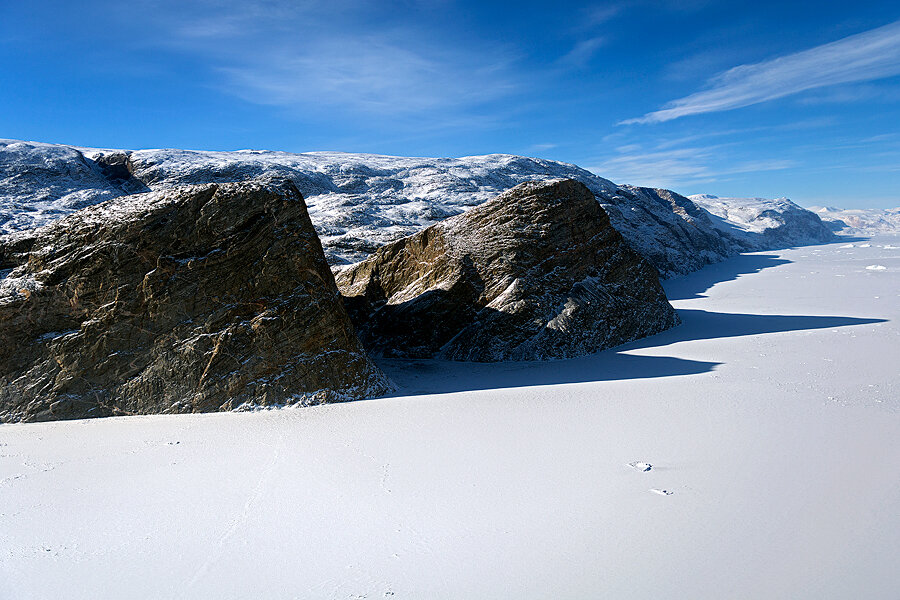Why Greenland could lose more of ice sheet than predicted
Loading...
Researchers say they have uncovered perennial freshwater lakes embedded within the upper layers of Greenland's ice sheet – previously unknown features that could play a role in the rate at which the sheet loses mass in a warming climate.
The discovery comes as glaciologists are still trying to digest news from a year ago that the southeastern section of the ice sheet hosts a year-round aquifer of liquid water. The aquifer covers some 27,000 square miles and ranges from 16 to nearly 165 feet thick, researchers have estimated. Since then, researchers have found other aquifers.
The perennial lakes and aquifers are acting as a kind of internal thermometer, signaling that "the ice sheet is warming, not only from the surface but internally as well," noted Lora Koenig, a research scientist at the National Snow and Ice Data Center in Boulder, Colo., during a briefing Monday at the fall meeting of the American Geophysical Union in San Francisco. The meeting runs through Friday.
The presence of these features suggests that models are underestimating the amount of mass the ice sheet is projected to lose over the medium term, Dr. Koenig said.
The lakes, as well as the aquifers, appear along the low-altitude margins of the nearly two-mile-thick ice sheet in a region that researchers call the sheet's ablation zone, where ice sheets typically shed mass. They are embedded in thick layers of old snow that eventually will become ice added to the ice sheet underneath.
Taken together, the aquifers and lakes trace nearly the full perimeter of the ice sheet. Collectively, they amount to a large reservoir of water available to percolate down below the ice and heat and lubricate it from below. This speeds the pace at which the ice sheet loses mass. Water from surface melt accounts for about half of that loss.
The behavior and survivability of the ice sheet's lakes, known as supraglacial lakes, from one summer to the next is of interest because the lakes may well migrate farther inland to higher elevations, dotting a larger area of the ice sheet as the climate warms.
In a modeling study published on Sunday in the journal Nature Climate Change, an international team led by Amber Leeson, a research fellow at the University of Leeds in Britain, estimates that the number of supraglacial lakes will march inland by 60 to 70 miles in southwestern Greenland by 2060, depending on the greenhouse-gas emissions scenario used. This would increase the area of ice they inhabit by some 50 percent.
Koenig and colleagues found the embedded lakes in 2010, during that year's field campaign by NASA's IceBridge project. Aircraft equipped with laser altimeters as well as ice-penetrating radar flew over one area where supraglacial lakes had formed the previous summer.
Researchers initially thought that the radar returns they saw were bounding off an ice lens in the thick sheath of old snow. But after they analyzed the results from the IceBridge flyover, it became clear that the aircraft's four types of radar had detected liquid water.
In essence, the lakes form during the melt season, and if they don't drain into another supraglacial lake or plunge through crevasses or conduits that open in the ice, they get covered with ice and snow that will insulate them from the frigid air in winter.
Researchers also have found that the ice sheet's aquifers are more abundant than last year's initial discovery might suggest.
Based on further data, a team led by Richard Forster, a geophysicist at the University of Utah in Salt Lake City, has found that along Greenland's east coast, the aquifer extends farther north, with additional evidence for an aquifer appearing at the island's northwest corner.
Using data from three years of NASA overflights of Helheim Glacier, one of the ice sheet's many outlet glaciers, the team has noted that one of the aquifers in the area appears to be draining.
Mapping the extent of the aquifers is getting a boost from orbit. Satellite-borne instruments, Dr. Forster noted at Monday's briefing, can now spot the aquifers, providing annual snapshots on the distribution and state of the aquifers. This reduces the time and expense of compiling observations from field camps on the ice or via aircraft.
The space-based mapping results correspond "quite well" with ice-sheet-model predictions of where the aquifers should be, Forster added. Those persistent features in computer simulations of Greenland's ice sheet were once thought to be errors because no one had yet found an aquifer.
"A lot of these results are new enough that we're trying to wrap our heads around them," acknowledges Mike MacFerrin, a graduate student at the University of Colorado at Boulder and a researcher at the school's Cooperative Institute for Research in Environmental Sciences, which is run in partnership with the National Oceanic and Atmospheric Administration.
"There's a whole lot more we don't know than we do know at the moment," he said Monday at the briefing.






